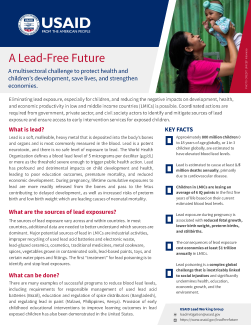A multisectoral challenge to protect health and childrenʼs development, save lives, and strengthen economies.
Eliminating lead exposure, especially for children, and reducing the negative impacts on development, health, and economic productivity in low and middle income countries (LMICs) is possible. Coordinated actions are required from government, private sector, and civil society actors to identify and mitigate sources of lead exposure and ensure access to early intervention services for exposed children
What is lead?
Lead is a soft, malleable, heavy metal that is deposited into the bodyʼs bones and organs and is most commonly measured in the blood. Lead is a potent neurotoxin, and there is no safe level of exposure to lead. The World Health Organization defines a blood lead level of 5 micrograms per deciliter (μg/dL) or more as the threshold severe enough to trigger public health action. Lead has profound and detrimental impacts on child development and health, leading to poor education outcomes, premature mortality, and reduced economic development. During pregnancy, lifetime cumulative exposures to lead are more readily released from the bones and pass to the fetus contributing to delayed development, as well as increased risks of preterm birth and low birth weight which are leading causes of neonatal mortality.
What are the sources of lead exposures?
The sources of lead exposure vary across and within countries. In most countries, additional data are needed to better understand which sources are dominant. Major potential sources of lead in LMICs are industrial activities, improper recycling of used lead acid batteries and electronic waste, lead-glazed ceramics, cosmetics, traditional medicines, metal cookware, spices, vegetables grown in contaminated soils, lead-based paints, toys, and certain water pipes and fittings. The first “treatment” for lead poisoning is to identify and stop lead exposures.
What can be done?
There are many examples of successful programs to reduce blood lead levels, including requirements for responsible management of used lead acid batteries (Brazil), education and regulation of spice distributors (Bangladesh), and regulating lead in paint (Malawi, Philippines, Kenya). Provision of early childhood educational interventions to improve learning outcomes in lead exposed children has also been demonstrated in the United States.
What is USAID doing to address toxic lead exposure?
As a starting point, USAID has committed to championing the phase out of lead from consumer goods, by leveraging USAIDʼs global presence to convene around, advocate for, and support lead mitigation efforts by partner governments. Furthermore, USAID prohibits the use of lead paint and lead-containing construction materials in all USAID projects and activities. USAID is also supporting country-level efforts in India, South Africa, and Bangladesh to identify and mitigate sources of lead exposure. This is in addition to USAIDʼs investments in nutrition, education, and early childhood development, which are vital for minimizing the negative impacts of lead exposure.
What is USAID prioritizing looking forward?
USAID is focusing on reduction of lead sources and exposure through:
Eliminating lead in consumer goods as a first step in addressing widespread exposures to lead in LMICs. This includes working through the Global Alliance to Eliminate Lead Paint to develop and enforce laws to ban lead additives in paint.
Conducting assessments of local sources of exposure to best inform an appropriate response, including surveys of blood lead levels alongside environmental exposure assessments.
Elevating the issue of lead exposure in high-level global fora, alongside the U.S. government interagency.
Mobilizing resources to accelerate implementation.

